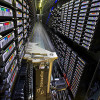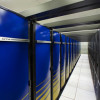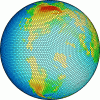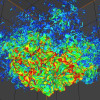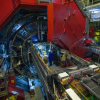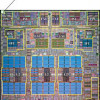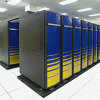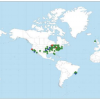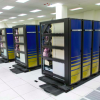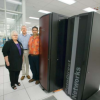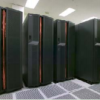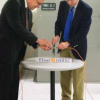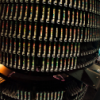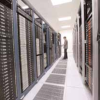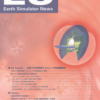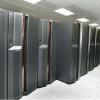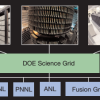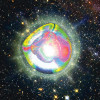NERSC Center News
NERSC Builds Gateways for Science Sharing
Programmers at the Department of Energy's National Energy Scientific Research Computing Center (NERSC) are working with science users to design custom web browser interfaces and analytics tools, a service called “science gateways,” which will make it easier for them to share their data with a larger community of researchers. Read More »
NERSC Delivers 59.9 Petabytes of Storage with Cutting-Edge Technology
NERSC's High Performance Storage System (HPSS) can now hold 59.9 petabytes of scientific data — equivalent to all the music, videos or photos that could be stored on approximately 523,414 iPod classics filled to capacity. This 37-petabyte increase in HPSS storage was made possible by deploying cutting-edge technologies Read More »
VisIt Supported on Cray Systems
Scientists computing on NERSC's Cray XT4 system, called Franklin, can have it all. Now that VisIt, one of the most popular frameworks for scientific visualization, is available on Franklin, users can run their simulations on the machine and visualize the output there too. Read More »
Speeding Up Science Data Transfers Between Department of Energy Facilities
As scientists conduct cutting-edge research with ever more sophisticated techniques, instruments, and supercomputers, the data sets that they must move, analyze, and manage are increasing in size to unprecedented levels. The ability to move and share data is essential to scientific collaboration, and in support of this activity network and systems engineers from the Department of Energy's (DOE) Energy Sciences Network (ESnet), National Energy Research Scientific Computing Center (NERSC) and Oak Ridge Leadership Computing Facility (OLCF) are teaming up to optimize wide-area network (WAN) data transfers. Read More »
NERSC Increases System Storage and Security for Users
Throughout the month of March the Cray XT4 machine Franklin underwent a series of upgrades and improvements, including a major I/O upgrade. The disk capacity of the scratch file system was increased by 30% to 460 TB, and the I/O bandwidth was nearly tripled to an aggregate write performance of 32 GB/sec, compared to 11 GB/s before the upgrade. Read More »
Berkeley Lab Checkpoint Restart Improves Productivity
The new version Berkeley Lab Checkpoint Restart (BCLR) software, released in January 2009, could mean that scientists running extensive calculations will be able to recover from major crashes – if they are running on a Linux system. This open-source software preemptively saves the state of applications using the Message Passing Interface (MPI), the most widely used mechanism for communication among processors working concurrently on a single problem. Read More »
Green Flash Project Runs First Prototype Successfully
Berkeley Lab’s Green Flash project, which is exploring the feasibility of building a new class of energy-efficient supercomputers for climate modeling, has successfully reached its first milestone by running the atmospheric model of a full climate code on a logical prototype of a Green Flash processor. Read More »
NERSC to Provide Resources to INCITE Projects Studying Combustion, Fusion Energy, Materials and Accelerator Design
Researchers tackling some of the most challenging scientific problems, from improving energy efficiency in combustion devices to developing new particle accelerators for scientific discovery to studying properties of new materials, have been awarded access to supercomputing resources at the U.S. Department of Energy’s (DOE) National Energy Research Scientific Computing Center (NERSC). Read More »
NERSC Releases Software Test for Its Next Supercomputer
The Department of Energy’s National Energy Research Scientific Computing Center (NERSC) is looking for a new supercomputer, but is not willing to spend millions of dollars on just any machine. The computer scientists and engineers want to know that their new supercomputer can reliably handle a diverse scientific workload, so they’ve developed the Sustained System Performance (SSP) Benchmarks, a comprehensive test for any system they consider. Read More »
NOAA Awarded 2.6 Million Processor Hours at NERSC to Run Climate Change Models
The U.S. Department of Energy’s (DOE) Office of Science will make available more than 10 million hours of computing time for the U.S. Commerce Department’s National Oceanic and Atmospheric Administration (NOAA) to explore advanced climate change models at three of DOE’s national laboratories as part of a three-year memorandum of understanding on collaborative climate research signed today by the two agencies. Read More »
Global Reach: NERSC Helps Manage and Analyze LHC Data
Over 15 million gigabytes of data per year will need to be stored, processed, backed up, and distributed to researchers across the world, when the Large Hadron Collider (LHC) begins smashing together beams of protons to search for new particles and forces, and beams of heavy nuclei to study new states of matter. Managing this mountain of data requires an international effort, with portions of the beams of protons to search for new particles and forces, and beams of heavy nuclei to study new… Read More »
New Line of Security for NERSC Computers
The supercomputers at NERSC have a new line of defense against hackers with the installation of a specially instrumented version of SSH. This version of SSH allows NERSC’s intrusion detection systems to analyze user activity while maintaining the security and privacy advantages of using SSH. “In the past few years SSH has become a standard and is required for all users logging into NERSC systems,” says Craig Lant, NERSC Security Analyst. SSH is a security program that provides secure… Read More »
Workshop on Risk Management Techniques and Practice for HPC Centers
On September 17 and 18, managers and key staff from high performance computing centers (HPCC) across the globe arrived in San Francisco, Calif. for a DOE workshop on risk management techniques and practice. Participants discussed current and emerging techniques, practices, and lessons learned for effectively identifying, understanding, managing, and mitigating risks associated with acquiring leading-edge computing systems at HPCCs.“High-performance computing, by its very nature, is an… Read More »
Ninth Annual ACTS Workshop Tackles “Building Robust, Scalable, and Portable Software”
Forty applications and tool developers from around the globe met at the Berkeley Lab’s Oakland Scientific Facility, home of NERSC, on August 19–22, for the 9th annual Advanced CompuTational Software (ACTS) Collection workshop on “Building Robust, Scalable and Portable Software.”The four-day workshop introduced the ACTS Collection to scientists whose research demands include large amounts of computation, complex software integration, distributed computing, the use of robust numerical… Read More »
Visualization Team Develops Benchmark for Scientific Graphics Software
The NERSC Analytics Team has developed a benchmark for the high performance graphics industry standard OpenGL, called svPerfGL. This benchmark focuses on measuring OpenGL rendering performance in the presence of extremely heavy graphics payload with relatively few OpenGL state changes, which is a typical of a workload incurred by scientific visualization applications. In contrast, industry standard benchmarks like SPECviewperf generate workloads typical of CAD and gaming applications, which do… Read More »
Delegation from France’s Strategic Council for HPC Visits LBNL
On Wednesday, August 27, a delegation from the French Strategic Council for High Performance Computing visited with Berkeley Lab Computing Sciences managers and staff to discuss research in scientific data management, algorithm development, computer architectures, collaborations with the University of California Berkeley, and other issues ranging from staffing to budgeting. The council was established by the French Ministry of Research to advise the government on investments and research… Read More »
New at NERSC Profiles
Shane Canon, Group Leader for Data Systems Group Shane Canon credits the cool, breezy climate and cosmopolitan cultural diversity of California’s Bay Area for bringing him back toBerkeley and NERSC, after a three-year stint at the Oak Ridge National Laboratory in Tennessee. And, the new job was nice too. He will be leading the new Data Systems Group, which will be responsible for the NERSC Global Filesystem (NGF) and associated activities within the center.“I like to tell people at NERSC… Read More »
Orbach Presented Souvenir from Seaborg
As part of his visit to Berkeley Lab on Friday, May 30, DOE Under Secretary of Science Ray Orbach met with representatives of Computing Sciences. ALD Horst Simon and NERSC Director Kathy Yelick opened the meeting by presenting Orbach with a framed memento from the decommissioned IBM supercomputer Seaborg and thanking him for his support of computational science.The Under Secretary quickly showed his knowledge of computing technology and asked if that was the Power 3 machine, and this led to… Read More »
NERSC Users Report 6,500 Scientific Publications in Five Years
Over a five-year period, researchers using HPC systems at the U.S. Department of Energy’s National Energy Research Scientific Computing Center (NERSC) have reported producing 6,593 scientific publications as a result of running their applications at NERSC. Beginning in 2003, NERSC staff have asked users to list resulting publications as they request allocations for the coming year. The number of publications has grown steadily in each of the five years in which the data has been collected. In… Read More »
GRID CONFERENCE
NERSC staff presented their work at the Open Source Grid & Cluster Conference, which showcased the latest grid and cluster software, including Globus, Grid Engine, Rocks, Ganglia and UniCluster Express. The conference took place May 12-16 in Oakland. Shreyas Cholia, who has worked on connecting NERSC systems to the Open Science Grid, gave a talk about NERSC’s certification authority service. He, along with Dan Gunter and Brian Tierney from the Computational Research Division (CRD) at… Read More »
NERSC Researcher John Shalf Discusses Low-Power Supercomputer
Microprocessors from portable electronics like iPods could yield low-cost, low-power supercomputers for specialized scientific applications, according to computer scientist John Shalf. Read More »
High Performance Humanities
On April 21, the National Endowment for the Humanities (NEH) announced something new: they would be teaming up with the U.S. Department of Energy to offer one million CPU hours on supercomputers at NERSC for use by researchers in the humanities. See this article at HPCwire.... Read More »
Berkeley Lab Researchers Propose a New Breed of Supercomputers for Improving Global Climate Predictions
Three researchers from the Department of Energy’s Lawrence Berkeley National Laboratory have proposed an innovative way to improve global climate change predictions by using a supercomputer with low-power embedded microprocessors, an approach that would overcome limitations posed by today’s conventional supercomputers. Read More »
SPOTLIGHT
CONTENT MASTER Harvey Wasserman from the Science-Driven System Architecture Team has been chosen as chair of the technical program for SC07, which will take place in Reno in November. COGNITIVE COMPUTING, BETTER SEARCHING NERSC and CITRIS, the Center for Information Technology Research in the Interest of Society, co-hosted two meetings at UC Berkeley this month that focused on cognitive computing and online search technologies. NERSC Director Horst Simon gave the opening remark in both… Read More »
The Greening of High Performance Computing
Will power consumption become the limiting factor for future growth in high performance computing (HPC)? Berkeley Lab's Associate Laboratory Director for Computing Sciences, Horst Simon, addressed this topic in the Distinguished Lecture Series in Petascale Simulation at the University of Texas at Austin’s Institute for Computational Engineering and Sciences and the Texas Advanced Computing Center on April 10, 2008. Available by webcast. Read More »
Living the Vision: A Profile of Kathy Yelick
Featured in the February / March 2008 issue of the European magazine Scientific Computing World, a profile of NERSC Division Director Kathy Yelick titled "Living the Vision." Read More »
Making “Parallel Programming” Synonymous with “Programming”
UPCRC research targets single-socket parallel programming for mainstream computing and applications. Read more in this article with an interview of NERSC Director Kathy Yelick. Read More »
Berkeley Lab Researchers Lead Parallel Computing Research Center at UC Berkeley
Computing sciences researchers at Lawrence Berkeley National Laboratory are part of a team leading a new research center in a partnership with Intel and Microsoft to accelerate developments in parallel computing and advance the powerful benefits of multicore processing to mainstream consumer and business computers. Read More »
Making Impact on Science
With its mission to support both high-impact and broad-impact science, NERSC is providing DOE 678.51 million MPP hours on its four supercomputers in 2008 for research in disciplines that include climate, material science, astrophysics, life sciences, computer science and combustion. NERSC can offer more computing resources this year thanks to the new Cray XT4, named Franklin after Benjamin Franklin. With three other supercomputers available to serve its 3,000 users, NERSC continues to… Read More »
Cray Workshop
NERSC hosted a recent Cray Technical Workshop, which included presentations from NERSC staff and scientists who have used Cray supercomputers for their research.The workshop, which took place in San Francisco last month, featured Bill Kramer, Zhengji Zhao and Katie Antypas from NERSC. Kramer, NERSC’s General Manager, talked about the deployment of Franklin, the new Cray XT4 bought last year. Zhao, a consultant, discussed the performance of VAST on Franklin. VAST (Vienna Ab initioSimulation… Read More »
Sharing Expertise
NERSC and the Swiss National Computing Centre (CSCS) have signed a memorandum of understanding for a staff exchange program between the two centers. The agreement gives more formal structure to already existing ties between the two centers. Berkeley Lab Associate Director for Computing Sciences Horst Simon is a member of the CSCS advisory board. Both centers also share a common technological focus, having selected Cray XT supercomputers as their primary systems after… Read More »
SPOTLIGHT: Scientific Computing Magazine Article
Scientific Computing Magazine Features SciDAC Outreach Center An article on the role and successes of the SciDAC Outreach Center, which is run by NERSC researcher David Skinner appeared in a recent issue of Scientific Computing magazine.; David Skinner SciDAC (Scientific Discovery through Advanced Computing) is a DOE Office of Science program that supports the development of software tools for tackling research using terascale computers. The Outreach Center, launched last year, serves… Read More »
A Modest Proposal for Petascale Computing
LBNL researchers have started to explore what a multi-petaflop computer architecture might look like. Read more from an editorial in the February 8 issue of HPCwire titled “A Modest Proposal for Petascale Computing.” Read More »
Leading Supercomputing Centers in Switzerland and United States to Share Staff Expertise, Experience
The Swiss National Computing Centre (CSCS) and the National Energy Research Scientific Computing Center (NERSC) at Lawrence Berkeley National Laboratory have signed a memorandum of understanding for a staff exchange program between the two centers. Read More »
DOE Allocates NERSC Supercomputing Resources to Research Combustion, Climate Change, Energy, Accelerators
The U.S. Department of Energy announced today that it is allocating about 10.4 million CPU hours on supercomputers at the National Energy Research Scientific Computing Center (NERSC) at Lawrence Berkeley National Laboratory as part of a program to accelerate scientific discoveries in multiple disciplines, including climate, physics, combustion and material science. Read More »
The Next Step in Powering Computers
A report by Richard Hart of KGO-TV (ABC 7 in San Francisco) describes the expanding energy consumption of data centers — and how some large Silicon Valley companies are now building outside the area because they can't get enough electricity. Read More »
National Energy Research Scientific Computing Center Announces Acceptance of One of the World's Largest Supercomputers
The U.S. Department of Energy’s (DOE) Lawrence Berkeley National Laboratory and Cray Inc. today announced the successful completion of the acceptance test of one of the world’s largest supercomputers. Installed at the DOE’s National Energy Research Scientific Computing Center (NERSC), the powerful Cray XT4™ system contains nearly 20,000 processor cores and has a top processing speed of more than 100 teraflops. Read More »
Model Comparisons
Scientists from the Advanced Plasma Microturbulence Project have published several papers recently that show how they resolve the significant differences between two types of electron temperature gradient (ETG) turbulence simulations in fusion research. The researchers have been running simulations at NERSC using particle-in-cell (PIC) and continuum gyrokinetic codes in order to reconcile the large gap of electron thermal conductivity values between the two types of simulations.Investigating… Read More »
SPOTLIGHT
VISIT FROM STUTTGART COMPUTING CENTER DELEGATION Wolfram Ressel, Rector of the University of Stuttgart, and three senior representatives of the High Performance Computing Center Stuttgart (HLRS), visited Lawrence Berkeley National Laboratory and NERSC in October. The visitors were particularly interested in energy-efficient architectural designs being drawn up for Berkeley Lab's planned Computational Research and Theory facility, which will house both NERSC and the Computational Research… Read More »
Prof. Kathy Yelick Named New Director for DOE’s National Energy Research Scientific Computing Center
Dr. Katherine A. Yelick BERKELEY, Calif.—Kathy Yelick, a professor of computer science at the University of California at Berkeley and an internationally recognized expert in developing methods to advance the use of supercomputers, has been named director of the Department of Energy’s National Energy Research Scientific Computing Center (NERSC). NERSC is DOE’s flagship computing center for unclassified research and is managed by Lawrence Berkeley National Laboratory. The center provides… Read More »
Up to Speed
A DOE workshop hosted by NERSC brought together the international supercomputing community in May to identify challenges for deploying petascale systems, a collaboration that resulted in a series of recommendations. The two-day meeting in San Francisco attracted about 70 participants from roughly 30 supercomputer centers, vendors, other research institutions and DOE program managers from Advanced Scientific Computing Research (ASCR),… Read More »
Wanted: Killer Apps
NERSC staff members are playing an increasingly active role in high-performance computing software integration and development, as they face a greater demand for marrying software from a variety of supercomputer makers with applications from a wide range of scientific fields. That’s the message from David Skinner, head of NERSC’s Open Software and Programming Group, which carries out in-house software development and deployment projects to help researchers run their… Read More »
Open for Science
More NERSC users can now launch and manage their work at multiple computing sites by going through a centralized grid, thanks to efforts to connect NERSC’s systems to the Open Science Grid (OSG). The SGI Altix 350 visualization server, named DaVinci, joined the OSG last month, the latest in a long-range plan to connect all NERSC supercomputers to the grid, said Shreyas Cholia, a member of the Open Software and Programming Group at NERSC. Making NERSC part of the more… Read More »
Swiss Connection
NERSC General Manager Bill Kramer (left) led a tour of NERSC’s computer room for visitors from the Swiss National Supercomputing Centre. The man from right is Richard Alexander (Senior System Engineer), Hussein Harake (System Engineer), Domink Ulmer (COO, Head of Administration) and Ladina Gily (Event Manager, HR Manager, Head of Facility Management). NERSC hosted four visitors from CSCS (Swiss National Supercomputing Centre) last Friday, May 4. After NERSC staff members gave… Read More »
Confronting Parallelism: The View from Berkeley
To explore the important new paper on the challenges of parallelism, "The View from Berkeley," HPCwire talked with NERSC computer scientist John Shalf and David Patterson, professor of computer science at UC-Berkeley. Shalf and Patterson are among the co-authors of "The View from Berkeley. Read More »
Cray Delivers First Third of the Franklin XT4 System to NERSC
On Tuesday, January 16, 2007, NERSC received the first installment of its new Cray XT4 supercomputer. Although a test system had been delivered the previous fall, the delivery of 36 cabinets (including 3,336 computational dual core nodes) marks the start of the installation of the full system, which is expected to go into production this summer. Read More »
DOE INCITE Program Awards Large Allocations at NERSC to Study Supernovae, Fusion Energy, Climate Change, Combustion, Chemistry and Accelerator Design
The U.S. Department of Energy announced today that it has allocated a large amount of supercomputing resources from the National Energy Research Scientific Computing Center (NERSC) at Lawrence Berkeley National Laboratory as part of an initiative to accelerate scientific research and promote innovations in public institutions and private industry. Read More »
Horst Simon Steps Down As NERSC Director
Horst Simon, who has been director of DOE's National Energy Research Scientific Computing Center (NERSC) since early 1996, announced last month that he was stepping down in order to focus his energy on the two other positions he holds at Lawrence Berkeley National Laboratory. Once a new director for NERSC is hired, Simon will concentrate on his duties as Associate Laboratory Director for Computing Sciences and Computational Research Division (CRD) Director. With the search for a new NERSC leader officially under way, Simon took some time to talk about his decision and how he sees his future. Read More »
Berkeley Lab to Showcase HPC and Networking Leadership in Talks, Demos at SC06 Conference
Computing and networking experts from the U.S. Department of Energy's Lawrence Berkeley National Laboratory will share their leadership expertise via talks, technical papers and demonstrations at the SC06 conference to be held Nov. 11–17 in Tampa , Fla. Read More »
The Software Challenges of Petascale Computing
In this HPCwire interview, Kathy Yelick, one of the world's leading performance evaluation experts, discusses software challenges related to petascale and other large-scale computing systems. Yelick is a professor of computer science at UC Berkeley, with a joint appointment in Lawrence Berkeley Lab's Computational Research Division, where she leads the Future Technologies Group and the Berkeley Institute for Performance Studies. Read More »
The Yin and Yang of Understanding Data
When the Department of Energy's Office of Science announced the latest round of awards in the Scientific Discovery through Advanced Computing (SciDAC) program in September, the funded projects included a new Center for Enabling Technologies that will focus on meeting the visualization and analytics needs of scientists. Called the SciDAC Visualization and Analytics Center for Enabling Technologies, or VACET, the project will be co-led by Wes Bethel, head of the Visualization Group at Lawrence Berkeley National Laboratory, and Chris Johnson, director of the Scientific Computing Institute of the University of Utah. Read More »
LBNL to Lead Five Projects, Partner in Eight Others under DOE's Scientific Discovery through Advanced Computing Program
Under the second round of the Scientific Discovery through Advanced Computing (SciDAC) program announced today by the U.S. Department of Energy, Lawrence Berkeley National Laboratory will lead five of the 30 projects and play a key partnership role in eight others. Read More »
INCITE Allocation Helping Drive Research in Future Accelerator Design
Using an allocation of 2.5 million processor hours on Seaborg at NERSC, a team led by Cameron Geddes of Lawrence Berkeley National Laboratory is creating detailed 3D simulations of laser-driven wakefield particle accelerators (LWFAs), providing crucial under- standing of the next generation of particle accelerators and ultrafast applications in chemistry and biology. The allocation was awarded under DOE’s Innovative and Novel Computational Impact on Theory and Experiment … Read More »
First Cabinet of NERSC’s New Cray Supercomputer Arrives for Testing
Within weeks of the announcement that NERSC’s next large system will be a follow-on to the Cray XT3 supercomputer, the first cabinet of the new machine has been installed for testing at Berkeley Lab’s Oakland Scientific Facility. The new supercomputer, which will be among the world’s fastest general purpose system, will have a guaranteed sustained performance of at least 16 trillion calculations per second (with a theoretical peak speed of 100 trillion calculations per second) when… Read More »
ESnet and Internet2 Partner To Deploy Next Generation Network for Scientific Research and Discovery
The Department of Energy’s (DOE) Energy Sciences Network (ESnet) and Internet2 — two of the nation’s leading networking organizations dedicated to research — today announced a partnership to deploy a highly reliable, high capacity nationwide network that will greatly enhance the capabilities of researchers across the country who participate in the DOE’s scientific research efforts. Read More »
Cray Wins $52 Million Supercomputer Contract with NERSC
Cray Inc. (NASDAQ GM: CRAY) and the U.S. Department of Energy (DOE) Office of Science announced today that Cray has won the contract to install a next-generation supercomputer at the DOE’s National Energy Research Scientific Computing Center (NERSC). The systems and multi-year services contract, valued at over $52 million, includes delivery of a Cray massively parallel processor supercomputer, code-named “Hood.” Read More »
Energy Department Providing Additional Supercomputing Resources to Study Hurricane Effects on Gulf Coast
The U.S. Department of Energy (DOE) announced today that the Office of Science has provided an additional 400,000 supercomputing processor-hours to the U.S. Army Corps of Engineers to simulate Gulf Coast hurricanes. The allocation brings the amount of computational time provided by DOE on supercomputers at its National Energy Research Scientific Computing Center (NERSC) in California to 800,000 processor-hours. Read More »
NERSC Users Report Over 1,400 Publications in 2005
As part of their 2006 allocations request, NERSC users were asked to submit lists of articles and conference papers resulting from their computations at NERSC over the preceding 12 months. A total of 1,448 publications, which had either been published or accepted, were noted. The total does not include those papers listed as “submitted” or “in preparation.” “This is an inspiring list of publications, both in the number and the breadth of science covered,” said NERSC Division… Read More »
201 Users Participate in Annual User Survey
The results from the 2005 user survey are now available and show generally high satisfaction with NERSC’s systems and support.Areas with the highest user satisfaction include account support services, the reliability and uptime of the HPSS mass storage system, and HPC consulting. The largest increases in satisfaction over last year’s survey include the NERSC CVS server, the Seaborg batch queue structure, PDSF compilers, Seaborg uptime, available computing hardware and network… Read More »
NERSC Global Filesystem Now Provides Seamless Data Access from All Systems
In February, NERSC deployed the NERSC Global Filesystem (NGF) into production, providing seamless data access from all of the Centers’ computational and analysis resources. With NGF, users can now run applications on Seaborg, for example, then use DaVinci to visualize the data without having to explicitly move a single data file. Greg Butler NGF is intended to facilitate sharing of data between users and/or machines. For example, if a project has multiple users who must all access a… Read More »
NERSC Team Takes StorCloud Honors at SC05 Conference
One of the goals of providing comprehensive computing resources is to make the different components “transparent” to the end user. But if you are staff members demonstrating a groundbreaking approach for accessing distributed storage, such invisibility isn’t so desirable. That was the case for a NERSC/LBNL team competing in the StorCloud Challenge at the SC05 conference held Nov. 12-18, 2005, in Seattle.The team, led by Will Baird of NERSC’s Computational Systems Group, was given an… Read More »
DOE's Office of Science Awards 18 Million Hours of Supercomputing Time to 15 Teams for Large-Scale Scientific Computing
Secretary of Energy Samuel W. Bodman announced today that DOE’s Office of Science has awarded a total of 18.2 million hours of computing time on some of the world’s most powerful supercomputers to help researchers in government labs, universities and industry tackle some of the most challenging scientific problems of our time. Read More »
New IBM Cluster to Enter Production January 9
NERSC will open its newest high performance computing system, an IBM cluster with 888 processors for parallel computing, for production use on Monday, Jan. 9, 2006. During the acceptance testing, users reported that codes ran from 3 to 10 times faster on the new cluster, Bassi, than on NERSC's other IBM supercomputer, Seaborg, leading one tester to call the system the “best machine I have seen.” Read More »
New IBM Cluster to Go into Production in January
NERSC users who run jobs on 256 to 512 processors will benefit from the “Bassi,” the new IBM cluster which goes into production on Monday, Jan. 9, 2006. During the acceptance testing, users reported that codes ran up to 10 times faster on Bassi than on Seaborg.The new machine is an IBM p575 POWER 5 system with 888 processors available for parallel scientific computation. Each Bassi processor has a theoretical peak performance of 7.6 Gflop/s. The processors are distributed among 111 compute… Read More »
NERSC, IBM Collaborate on New Software Strategy To Simplify Supercomputing
This month’s IBM announced an innovative software strategy in supercomputing which allows customers to leverage the General Parallel File System (GPFS) across mixed-vendor supercomputing systems for the first time. This strategy is the result of a direct partnership with NERSC. GPFS is an advanced file system for high performance computing clusters that provides high speed file access to applications executing on multiple nodes of a Linux or AIX cluster. GPFS’s scalability and performance… Read More »
NERSC Launches Linux Networx Supercomputer into Production
Linux Networx and the U.S. Department of Energy's (DOE) Office of Science announced today that DOE's National Energy Research Scientific Computing Center (NERSC) at Lawrence Berkeley National Laboratory has accepted a 722-processor Linux Networx Evolocity® cluster system for full production use by researchers across the nation. Read More »
New Data Analysis, Mathematics and Visual Analytics Server Enters Production
In mid-August, NERSC put into production a new server specifically tailored to interactive visualization and data analysis work. The 32-processor SGI Altix, called DaVinci, offers interactive access to large amounts of large memory and high performance I/O capabilities typically required to analyze the large datasets produced by the NERSC high performance computing systems (jacquard and seaborg). “With its 192 gigabytes of RAM and 25 terabytes of disk, DaVinci’s balance is biased toward… Read More »
NERSC Is First Production Site on ESnet’s Bay Area MAN
On August 23, the NERSC Center became the first of six DOE research sites to go into full production on ESnet’s new San Francisco Bay Area Metropolitan Area Network (MAN). Once completed, the new MAN will provide dual connectivity at 20 to 30 gigabits per seconds (10 to 50 times the current site bandwidths, depending on the site using the ring) while significantly reducing the overall cost. The connection to NERSC consists of two 10-gigabit Ethernet links. One link will be used for production… Read More »
NERSC’s Bill Kramer Is Honored by NASA, Cited by HPCwire
NERSC Center General Manager Bill Kramer received two very different honors recently: a NASA Group Achievement Award for the Advanced Air Transportation Technologies (AATT) Project Team, and inclusion in the HPCwire newsletter’s annual list of “People to Watch” in HPC. Bill, who came to Berkeley Lab from NASA Ames in 1996, was one of the original seven members of the AATT Project team from September 1994 to February 1996. He became the first AATT Program Office Director in 1995. Bill’s… Read More »
NERSC Reaches Another Checkpoint/Restart Milestone
On the weekend of June 11 and 12, IBM personnel used NERSC’s Seaborg supercomputer for dedicated testing of IBM’s latest HPC Software Stack, a set of tools for high performance computing. To maximize system utilization for NERSC users, instead of “draining” the system (letting running jobs continue to completion) before starting this dedicated testing, NERSC staff checkpointed all running jobs at the start of the testing period. “Checkpointing” means stopping a program in progress… Read More »
NERSC’s Nick Cardo Helps IBM Refine System Software Testing
Nick Cardo, NERSC’s IBM SP project lead, was invited earlier this year to give a customer perspective to staff at IBM’s test lab in Poughkeepsie, NY. Cardo spent two days at the facility, demonstrating how he runs various systems tests regularly on Seaborg, NERSC’s IBM supercomputer. For two days, Cardo worked side by side with IBM staff on their test SP, showing them how he runs tests on a daily basis. The result was that the IBM staff were able to see what a user encounters. “By… Read More »
Berkeley Lab to Host Sixth Workshop on the DOE Advanced CompuTational Software (ACTS) Collection for HPC Applications
A four-day workshop introducing the DOE Advanced CompuTational Software (ACTS) Collection will provide hands-on instruction in building robust scientific and engineering high-end computing applications. The workshop will be held Aug. 23-26 at the U.S. Department of Energy's Lawrence Berkeley National Laboratory in Berkeley, Calif. Read More »
ORNL’s David Dean Elected to Lead NERSC Users Group
NERSC Division Director Horst Simon announced this month that David Dean, a nuclear physics scientist from Oak Ridge National Lab, has been elected chair of the NERSC Users Group. Stephane Ethier, a fusion energy scientist from the Princeton Plasma Physics Lab, has been elected vice chair. “Both are long term users of NERSC with an excellent understanding of the issues facing NERSC users,” Simon wrote in his announcement. “I am looking forward to work with them for the benefit of all… Read More »
NERSC’s Storage Strategy Paying Off in Savings
Since relocating to Berkeley Lab almost 10 years ago, one of NERSC’s goals has been to consistently introduce new technologies without creating bottlenecks. In a program of planned upgrades to tapes with greater density, the Mass Storage Group has not only achieved this goal, but will save $3.7 million over the course of five years. Over that same time, from 2003 to 2007, the amount of data stored will grow from just over 1 terabyte to 11.3 terabytes. As computational science becomes… Read More »
NERSC Staff Help Pave the Way for Running Larger Jobs on Seaborg
As home to one of the largest supercomputers open for unclassified research, the NERSC Center has moved aggressively to devote a greater share of its processing time to jobs running on 512 or more processors.Since the start of Fiscal Year 2005 on Oct. 1, 2004, more than two-thirds of the processing time available on Seaborg has been utilized by jobs running on 512 or more processors (32 nodes). Seaborg comprises 6,080 computing processors. Through January, 76 percent of Seaborg’s processing… Read More »
DOE Allocates Massive Supercomputer Resources to Drive Advances in Combustion, Astrophysics and Protein Structure Research
Secretary of Energy Spencer Abraham announced today that 6.5 million hours of supercomputing time have been awarded to three scientific research projects aimed at increasing our understanding of ways to reduce pollution, gaining greater insight into how stars and solar systems form, and advancing our knowledge about how proteins express genetic information. Read More »
INCITE Awards 6.5 Million Hours at NERSC to Research in Combustion, Astrophysics and Protein Structure
Secretary of Energy Spencer Abraham announced on Dec. 22 that 6.5 million hours of supercomputing time at NERSC have been awarded to three scientific research projects aimed at increasing our understanding of ways to reduce pollution, gaining greater insight into how stars and solar systems form, and advancing our knowledge about how proteins express genetic information. “As one of the nation’s leading agencies for advancing scientific research, the Energy Department is proud to be able to… Read More »
Two NERSC Users Honored by AGU
At the 2004 American Geophysical Union (AGU) Fall Meeting, NERSC users Inez Yau-Sheung Fung and Garrison “Gary” Sposito were among the 12 recipients of AGU medals for excellence in research. The meeting was held Dec. 13-17 in San Francisco. Inez Fung Fung, director of the Center for Atmospheric Sciences and a professor at the University of California at Berkeley, was awarded the Roger Revelle Medal. Established in 1991, the Revelle Medal recognizes outstanding accomplishments or… Read More »
Berkeley Lab Scientists Gain New Insight on Photosynthesis
Solar power remains the ultimate Olympic gold medal dream of a clean, efficient and sustainable source of energy. The problem has been that in order to replace fossil fuels, we need to get a lot more proficient at harvesting sunlight and converting it into energy. Nature has solved this problem through photosynthesis. All we have to do is emulate it. Read More »
NERSC, LBNL Staff Share Expertise at Cyber Security Summit
When cyber security experts from some of the nation’s top research institutions gathered Sept. 27-28 for a summit meeting to better prepare for future cyber attacks, NERSC and LBNL were there to share their experience and expertise. Cyber Security Summit 2004, an invitation-only workshop held in Arlington, Va., was organized by the National Center for Atmospheric Research, with support from the National Science Foundation. A major driver for the meeting was the series of debilitating attacks… Read More »
INCITE PIs to Present Results at SC2004
The principal investigators of the three computational science projects enabled by the first year of allocations under the U.S. Department of Energy’s INCITE program will discuss their work in a series of presentations in the Berkeley Lab booth (#139) at the SC2004 conference in Pittsburgh. INCITE, the Innovative and Novel Computational Impact on Theory and Experiment program, sought out computationally intensive large-scale research projects that could make high-impact scientific advances… Read More »
The Fastest Computers in the World
Since 1993, the TOP500 list of the world's fastest supercomputers has been released twice a year. The publication of the 23rd list a few weeks ago during the International Supercomputer Conference in Heidelberg, Germany, was a much-anticipated and closely watched event. Read More »
NERSC, LBNL Staff to Share Expertise at Cyber Security Summit
When cybersecurity experts from some of the nation’s top research institutions gather Sept. 27-28 for a summit meeting to better prepare for future cyber attacks, NERSC and LBNL will share their experience and expertise. Cybersecurity Summit 2004, an invitation-only workshop to be held in Arlington, Va., is being organized by the National Center for Atmospheric Research, with support from the National Science Foundation. A major driver for the meeting was the series of debilitating attacks… Read More »
PDSF to Boost Processors, Performance
Researchers using the PDSF cluster managed by NERSC will soon have access to more processing power and benefit from a higher speed network connection for accessing archived data. New hardware is being shipped and is expected to be installed by the end of September. The additions include 48 nodes of dual Xeon processors and 10 nodes of dual Opteron processors. These will be added to the existing 550 processor cluster.The system’s connection to NERSC’s internal network will be upgraded from a… Read More »
DOE Office of Science INCITE Program Seeking Proposals for Large-Scale Scientific Computing
Secretary of Energy Spencer Abraham announced today that proposals are being accepted for a Department of Energy (DOE) Office of Science program to support innovative, large-scale computational science projects which will allow for high-impact scientific advances through the use of a substantial allocation of computer time and data storage at the department's scientific computing center in Berkeley, Calif.
Read More »
INCITE Update: Turbulence Researchers Find Smooth Sailing at NERSC
There are real advantages in computing at NERSC, and a project led by Professor P. K. Yeung of the Georgia Institute of Technology to study “Fluid Turbulence and Mixing at High Reynolds Number” now wants to take full advantage of those advantages. The project, one of three selected by DOE’s INCITE program, was initially awarded 1.2 million processor hours at NERSC. The project team was also awarded a similar allocation at an NSF computing center. Because the two grants had different… Read More »
Benchmarking Team from LBNL/NERSC Makes News in Japan
Late last year, four researchers from the NERSC Center and Lawrence Berkeley National Laboratory’s Computational Research Division spent nearly one week at the Earth Simulator Center in Japan. Their objective was to run a series of scientific applications on the Japanese supercomputer, in part to assess the viability of the Earth Simulator’s vector architecture for codes important to the DOE Office of Science mission. The visit merited an article and photo in the Japanese-language “ES… Read More »
NERSC Users Post Impressive Record of Published Results
In 2003, the Web site for requesting NERSC allocations added a field requesting information about scientific publications related to research using NERSC resources. As a result, NERSC users reported a total of 2,404 peer-reviewed papers based, at least in part, on work done at NERSC.The complete list, organized alphabetically by principal investigator, can be found on the Web at… Read More »
NERSC’s David Skinner Gets Hands on IBM Blue Gene Prototype
David Skinner, who is the lead NERSC consultant for the Seaborg system, was working on a performance monitoring project at IBM’s Watson Center in New York earlier this year when an unexpected opportunity presented itself. “There was a BlueGene/L prototype available while I was there, and IBM Research was interested in getting more experience with real users and codes on the machine,” Skinner said. “This was the first real contact NERSC has had with this architecture, which is one of the… Read More »
NERSC-ANL Blue Planet Proposal Serves as Blueprint for ASCI Purple
Two separate events, both aimed at dramatically advancing scientific computing and announced within a month of each other in late 2002, converged in 2003 and will result in DOE’s leadership in high-performance computing for years to come. The first step was the publication in October 2002 of an idea often referred to as “Blue Planet." A month later, DOE announced that IBM had been selected to build ASCI Purple, the fifth generation ASCI supercomputer for the stockpile stewardship program. Read More »
NERSC’s QCD Library is a Model Resource
Five years ago, when the first libraries of lattice QCD data were established at NERSC, the idea of making such information easily accessible to researchers at institutions around the world was a bold new approach. In fact, “The NERSC Archive” format, as it is colloquially known, has become a standard for the lattice storage format, which made exchanging lattices between groups much more efficient. The result is that lattice QCD researchers can avoid the time consuming and… Read More »
All NERSC Production Systems Now on the Grid
With the new year came good news for NERSC users – all of NERSC’s production computing and storage resources are now Grid-enabled and can be accessed by users who have Grid applications using the Globus Toolkit. As a result, Grid users now have access to NERSC’s IBM supercomputer (“Seaborg”), HPSS, the PDSF cluster, the visualization server “Escher,” and the math server “Newton.” Users can also get support for Grid-related issues from NERSC’s User Services Group. “Now that… Read More »
NERSC Helps Make Strides Toward Open Science Grid
In addition to making all of its production systems available via the DOE Science Grid, NERSC is also participating in the Open Science Grid initiative. Late last year, NERSC’s 400-processor PDSF cluster was integrated into a broad scientific grid currently connecting 27 sites in the U.S. and South Korea. Driven by the high energy physics community to help prepare for participation in multi-institution experiments on the Large Hadron Collider at CERN, the Open Science Grid (OSG) aims to tie… Read More »
Cray Testing Red Storm Software at NERSC
High-performance computing experts from the U.S. Department of Energy’s (DOE) National Energy Research Scientific Computing (NERSC) Center and Cray Inc. have completed the initial operating system and message-passing functional scalability testing for the Red Storm supercomputer currently being developed by Cray Inc. and DOE’s Sandia National Laboratories. The successful effort paves the way for the next stage of testing of I/O (input/output) of two potential Red Storm file systems. Red… Read More »
DOE Announces Major INCITE Allocations of NERSC Resources
The DOE Office of Science announced today that three key computational science projects have been chosen to receive a total of 4.9 million hours of supercomputing time at the NERSC Center. The projects are expected to significantly advance our understanding of the makeup of the universe, the chemical process by which plants convert sunlight to energy while removing carbon dioxide from the atmosphere, and the turbulent forces that affect everything from weather to industrial processes. Read More »
The Spinning Cube of Potential Doom
The Spinning Cube of Potential Doom visualizes passwords being sent "in the clear," that is, without encryption. These "cleartext" passwords can be easily intercepted, making them a security threat. (Image: Steve Lau) At SC03 in Phoenix, many attendees passing the SCinet network operations center were curiously compelled to stop and watch “The Spinning Cube of Potential Doom,” the brainchild of Steve Lau, staff member at the National Energy Research Scientific Computing Center (NERSC). The… Read More »
Lawrence Berkeley National Laboratory to Showcase Computing, Grids Expertise at SC2003 Conference
The Computing Sciences organization at the U.S. Department of Energy's Lawrence Berkeley National Laboratory will demonstrate its leadership in advancing science-driven supercomputing and next-generation Grid tools in a series of demonstrations and presentations at the SC2003 conference in Phoenix. Read More »
Modeling a Cosmic Bomb: DOE ‘Big Splash’ Award Produces a NERSC First
Earlier this year Lifan Wang of the Physics Division and his colleagues reported the first evidence of polarization in a “normal” Type Ia supernova (see Currents, Aug. 8). SN 2001el’s otherwise normal spectrum showed an unusual glitch, however, which has led to the best-ever supercomputer models of the shapes of these exploding stars. Read More »
INCITE Program to Allocate Major Department of Energy Office of Science Computing Resources to Key Scientific Projects
Proposals are now being accepted for a new Department of Energy (DOE) Office of Science program to support innovative, large-scale computational science projects, Secretary of Energy Spencer Abraham announced today. Read More »
Fourth Workshop on the DOE Advanced Computational Software Collection
The U.S. Department of Energy's Lawrence Berkeley National Laboratory is hosting a four-day workshop on the DOE Advanced CompuTational Software (ACTS) Collection, a set of software tools aimed at simplifying the solution of common and important computational problems. The workshop will be held Aug. 5-8 in Berkeley. Read More »






